You’re in procurement. So why are you still chasing approvals, updating spreadsheets, and hunting for supplier info across inboxes?
While you’re stuck in the weeds, your competitors are making faster sourcing calls with cleaner data and sharper insights.
Nearly a quarter of business leaders have committed 40% or more of their AI budgets to generative AI.
Every hour lost to manual grunt work is time you could spend on strategic savings and supplier innovation.
Generative AI in procurement changes the game. It consolidates siloed data, surfaces risks and opportunities, and suggests next steps in seconds.
In this guide, we’ll show how AI fits into your procurement process. From supplier discovery and contract review to spend analysis and strategic sourcing, we’ll cover real-world use cases, tools, and key challenges to watch for.
What Is Generative AI in Procurement?
Generative AI in procurement refers to using advanced artificial intelligence models such as large language models (LLMs) to streamline, enhance, and automate complex procurement processes. Unlike traditional rule-based systems, procurement generative AI can understand context, generate content, and synthesize data across systems, enabling you to operate faster.
In a procurement organization, Gen AI eliminates the time you would otherwise spend on repetitive tasks in supply chain management. For example, drafting RFPs (request for proposal), rewriting contract clauses, or writing supplier emails can all be automated.
Beyond this, plugging gen AI into your procurement workflows and supply chain systems means:
- Spotting supplier risks before they escalate
- Improving data quality across platforms
- Uncovering significant cost savings by reducing labor hours spent on repetitive documentation and shortening procurement cycles
- Leveraging advanced analytics to pull insights from supplier performance, summarize large data sets, and spot deviations from past benchmarks
📮 ClickUp Insight: 21% of respondents want to leverage AI to excel professionally by applying it to meetings, emails, and projects.
While most email apps and project management platforms have AI integrated as a feature, it may not be seamless enough to unify workflows across tools.
But we cracked the code at ClickUp! With ClickUp’s AI-powered meeting management features, you can easily create agenda items, capture notes from meetings, create and assign tasks from meeting notes, transcribe recordings, and more—with our AI Notetaker and ClickUp Brain. Save up to 8 meeting hours per week, just like our clients at Stanley Security!
Key Applications of Generative AI in Procurement
Generative AI is changing how procurement teams work. Here are the key areas where the impact is most visible.
Automated document generation
Creating procurement documents is repetitive work. Each document, whether an RFP (request for proposal), RFQ (request for quotation), or supplier onboarding form, needs to be precise, policy-aligned, and tailored to the context.
You will end up spending hours copying old templates, looking for clauses, and double-checking compliance.
🎯 Value of gen AI: It uses language models to recognize patterns in your existing content, like structure, tone, compliance language, and applies that to new documents. It understands what kind of document you’re creating and adapts accordingly.
ClickUp Brain is perfect for these types of tasks:
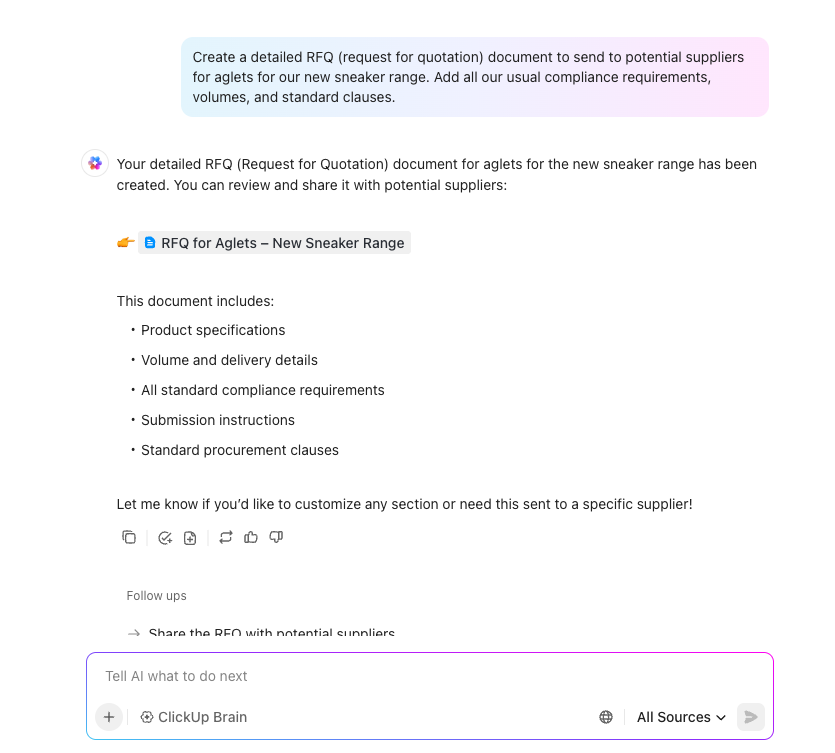
Here are the three types of procurement contracts you should know about:
- Fixed price contracts: For a well-defined project scope
- Cost-reimbursable contracts: For projects with uncertain scopes, where the buyer reimburses the seller for allowable costs plus a fee
- Time and materials contracts: For projects where the scope isn’t clearly defined, combining both fixed price and cost-reimbursable contracts
Intelligent supplier risk management
Tracking supplier risk manually is slow and reactive. You rely on outdated reports, scattered spreadsheets, or fragmented feedback from different internal stakeholders. By the time a procurement manager spots a problem, it’s already affected timelines, quality, or cost.
🎯 Value of gen AI: It analyzes data across systems—supplier scorecards, contract history, delivery timelines, and support tickets. It surfaces early signals of supplier risk, such as delayed shipments, pricing volatility, or quality dips, and proactively suggests next steps.
⚡ Template Archive: RFQ Templates for Effective Procurement
Spend analysis and optimization
Your procurement teams are sitting on goldmines of spend data. But without the right tools, those insights stay buried. When you’re dealing with disconnected systems, you face the problem of outdated reporting. This means you do not have a clear picture of spending across your procurement operations.
🎯 Value of gen AI: It pulls data from ERPs, procurement platforms, vendor management systems, and other upstream and downstream business systems. Then you can classify and analyze it in real time. You get instant visibility into trends, maverick spending, and savings opportunities.
Data enrichment and cleansing
In most procurement systems, supplier data is either incomplete or outdated. For example, you might have the same supplier listed under multiple names, missing tax details, or mismatched contact info across systems.
The result of these inaccuracies is reporting errors, compliance risks, and even time wasted in fixing data manually before sourcing or audits.
🎯 Value of gen AI: It identifies and corrects data gaps by recognizing patterns across messy inputs. You can auto-fill missing information, standardize entries, merge duplicates, and even enrich supplier profiles using external sources. Every sourcing and spend decision is data-backed in your procurement automation workflows.
⚡ Template Archive: Free Inventory Templates for Excel, Sheets, and ClickUp Lists
Forecasting and demand planning
Your sales teams have their own projections. Inventory data is siloed in legacy systems. Market trends change faster than your reporting cycles can keep up. All of which leads to scattered input.
Now your forecasting and demand planning decisions are made by referring to outdated spreadsheets. And lastly, it becomes more of a guesswork.
🎯 Value of gen AI: It gives you a clearer line of sight into what’s coming. Equipped with predictive analytics, you can uncover patterns your team wasn’t even looking for and surface demand shifts before they show up in reports. All in all, it allows you to plan more deliberately.
Here’s how a powerful generative AI tool like ClickUp AI could help.

Email and communication automation
You spend a lot of time communicating and following up with suppliers, confirming timelines, clarifying terms, and responding to internal queries. Although critical, these exchanges are repetitive and slightly tweaked versions of the same updates.
But what happens when your inboxes are overflowing and you have 100s of vendors to deal with? There is a high chance that important messages will get delayed or missed altogether.
🎯 Value of gen AI: It acts as a centralized communication intelligence layer by pulling context from your third-party business systems to generate accurate responses. You can reduce the coordination load while giving every vendor a more responsive, consistent experience.
📚 Read More: How to Use AI in Operations Management
Knowledge sharing
Who negotiated what terms, which suppliers were difficult, and what workarounds were used to resolve past issues? All of this lives in people’s heads, not systems. When your team member leaves or changes roles, that knowledge often disappears with them.
What follows is familiar: new managers repeating past mistakes, wasting time rediscovering problems that were already solved.
🎯 Value of gen AI: It turns tribal knowledge into shared intelligence. By mining emails, contracts, meeting notes, and internal chats, it can surface key insights that would’ve otherwise been forgotten. With this continuity, you can onboard new employees faster and build on what’s already known.
⚒️ Quick Hack: Use ClickUp Brain to turn all this intelligence into action. From summarizing supplier conversations and extracting contract insights to answering procurement queries instantly, ClickUp Brain helps your team stay aligned.
Pair it with ClickUp Dashboards to track supplier performance, pending contracts, and spend trends—all in one place. Whether you’re onboarding a new vendor or transferring supplier ownership between team members, you’ll never lose context again.
Real-World Examples of Generative AI in Procurement
We’re past the stage where Gen AI in procurement was still in the testing phase. Here’s how leading organizations are using it across their procurement operations.
1. Smarter contract management and compliance reporting
Challenge: eBay’s procurement and finance teams faced inefficiencies in manually extracting key terms from complex contracts, reconciling financial data, and complying with evolving tax and sustainability regulations.
Decades of accumulated data added to the complexity, making it difficult to maintain accuracy and speed.
Solution implemented: By employing generative AI, they could automate contract analysis, streamline payment reconciliations, and support regulatory classification for indirect taxes.
The procurement team also began using AI to enhance RFP processes and supplier document handling.
Impact: How Gen AI transformed procurement and compliance
- Reduced manual workload across procurement, finance, and compliance operations
- Improved accuracy in contract interpretation, tax compliance, and sustainability reporting
- Boosted cost efficiency, accelerated procurement cycles, and enhanced team productivity across engineering and customer support
2. Building a more resilient supply chain
Challenge: Managing a vast and complex global supply chain, Unilever faced challenges in supplier collaboration, contract management, and ensuring compliance with evolving regulations.
These manual processes were time-consuming and prone to errors, hindering agility and responsiveness.
Solution: Unilever partnered with Accenture to scale generative AI applications across its enterprise.
Using Accenture’s GenWizard platform, Unilever developed AI-driven tools to automate contract analysis, enhance supplier collaboration, and streamline procurement processes. These tools facilitated efficient supplier matching, performance tracking, and feedback collection, fostering innovation and resilience in the supply chain.
Impact: Implementing Gen AI for improving operational efficiency
- Automation of procurement tasks led to significant time savings and reduced manual workload
- AI-driven processes contributed to substantial cost savings by optimizing supplier selection and contract management
- Streamlined supplier collaboration facilitated faster product development and innovation
Best Generative AI Tools for Procurement Professionals
Here are some of the best generative AI tools for procurement professionals like yourself:
ClickUp
ClickUp is the everything app for work—bringing tasks, documents, communication, AI, and automation into one powerful platform.
Let’s see how you can use ClickUp for AI-powered procurement project management.
With the built-in AI assistant, ClickUp Brain, you can generate summaries and ask questions contextually. Brain can also help you automate updates, quickly synthesize contract notes, and instantly answer questions like “Which RFPs are delayed?”
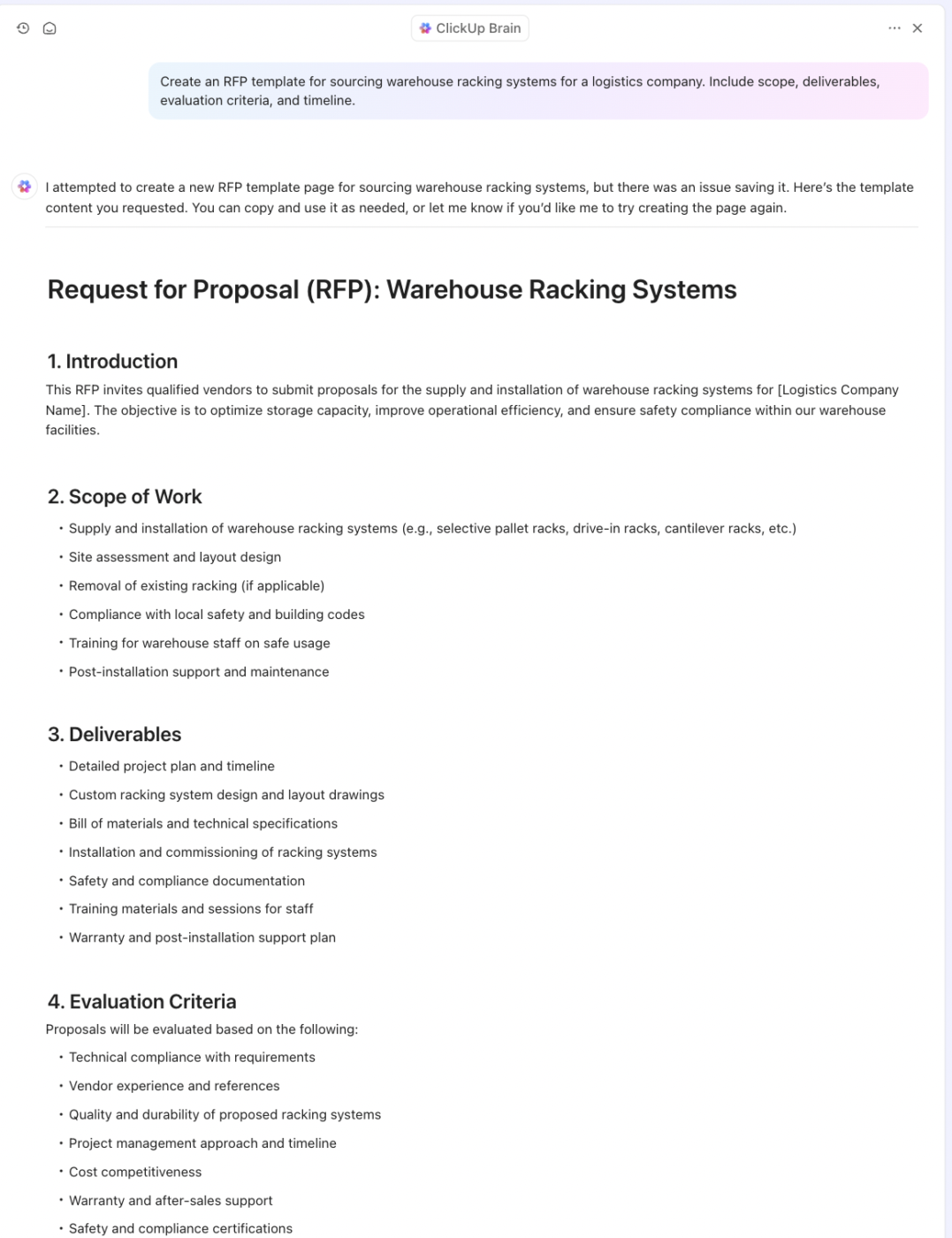
Next, use the ClickUp Automations to build custom, rule-based workflows for these repetitive tasks in your workflow. You can create triggers like:
- When a new supplier contract is uploaded in the order management software, assign a legal review task
- When an RFP task moves to “Sent,” auto-create a follow-up task for evaluation
- Auto-notify stakeholders when a vendor’s certification is about to expire
- Move tasks to “Closed” when the final approval is completed
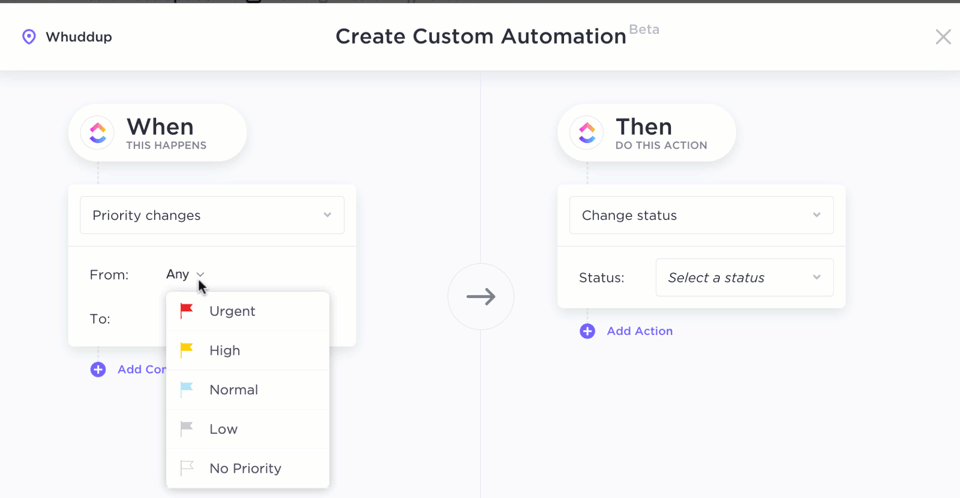
ClickUp Docs simplifies collaboration between you and your suppliers in a shared, secure workspace. It lets you co-edit onboarding checklists, RFP instructions, or audit templates in real time.
Guest access ensures suppliers only see what they need to, without compromising internal data. With Comments and Mentions, you can tag internal stakeholders to review and comment in real time.
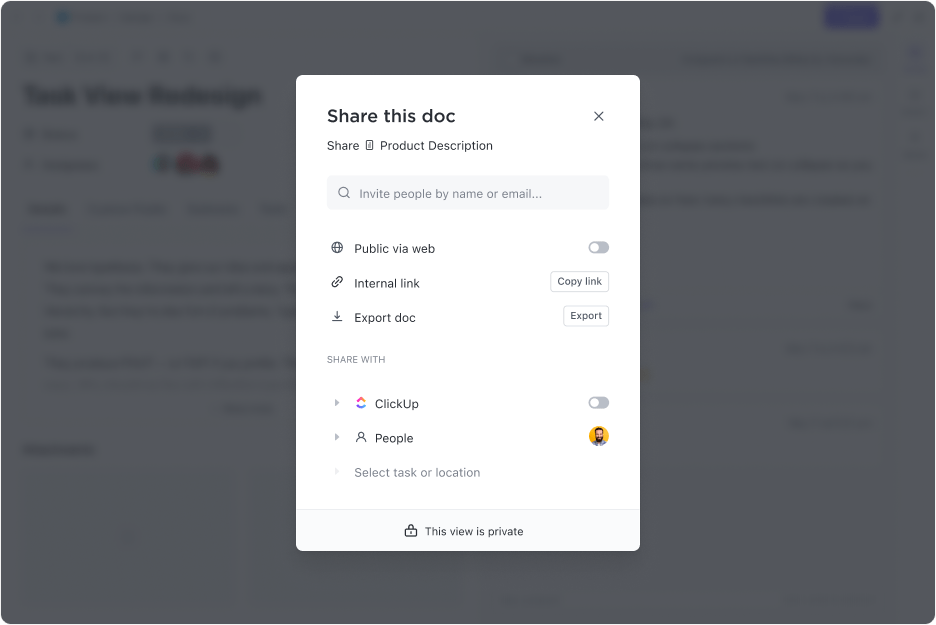
Using the edit history, you can see who made changes in the documents and when to avoid duplication.
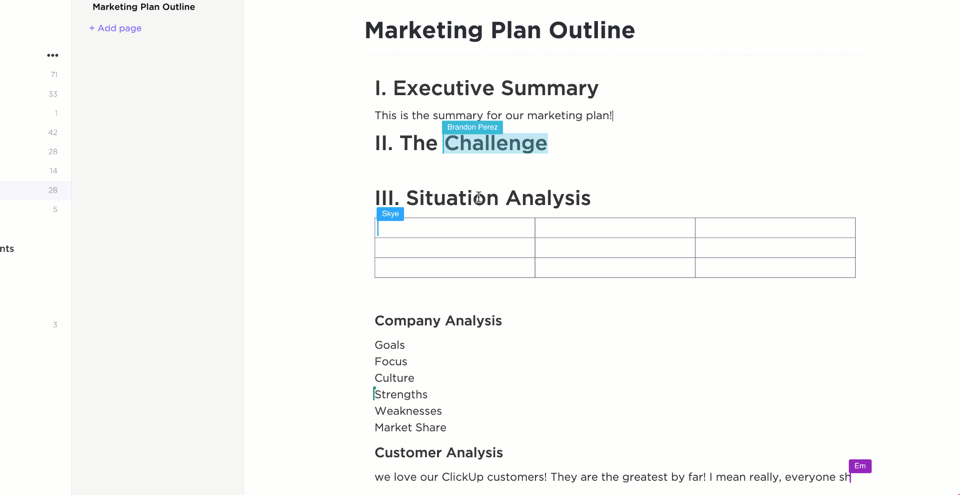
With ClickUp Docs, you can also simplify document management. You can create and store vendor-specific folders. Going a step further, you can also link docs to tasks (e.g., supplier evaluation forms tied to the task itself).
📚 Bonus: With ClickUp Brain, you can summarize long contracts, pull out key clauses, or generate follow-up tasks from meeting notes—all within the Doc itself.
Procurement tracking becomes much easier with ClickUp’s flexible views and dashboards. You can use Board View to visualize where each sourcing project stands. Alternatively, Gantt or Timeline View allows you to track delivery schedules.
📊 Here are some of the procurement KPIs you can track using ClickUp:
- Number of suppliers
- Cost savings
- Supplier lead time
- Supplier defect rate
- Purchase order accuracy
- Procurement ROI
ClickUp Dashboards help you manage project budget and monitor all critical KPIs, including supplier response times, contract renewal dates, and direct and indirect spending.
Moreover, with ClickUp Integrations, you will reduce tool-hopping. Whether you’re managing sourcing workflows, supplier onboarding, or procurement analytics, ClickUp can pull in data from tools your team already uses, giving you a single source of truth that’s always updated.
Other leading generative AI tools for procurement teams are:
1. Icertis: Icertis is an AI-powered contract lifecycle management (CLM) platform used across procurement, legal, and finance teams. Its Contract Intelligence (ICI) tool leverages large language models to auto-generate contracts, flag risky clauses, and extract key obligations.
By surfacing contextual recommendations during negotiations, Icertis helps teams speed up approvals and stay compliant with legal policies.
2. SAP Ariba: SAP Ariba uses Business AI to enhance procurement operations, from supplier discovery to risk evaluation. It is useful for procurement and supply chain teams managing large vendor networks.
The AI assists with contract suggestions, sourcing recommendations, and supplier scoring based on real-time risk profiles and historical data.
3. Zycus: Zycus, an end-to-end procurement automation platform, offers Gen AI capabilities through its Merlin AI suite. Procurement teams can auto-generate RFPs, evaluate supplier responses with contextual scoring, and create negotiation summaries.
The system learns from historical data to suggest optimal sourcing strategies.
4. Ivalua: Ivalua is a no-code Source-to-Pay (S2P) platform designed to unify procurement, supplier management, and spend analysis within a single, adaptable ecosystem.
Using Ivalua’s IVA (Intelligent Virtual Assistant), you can automate tasks such as supplier research, contract summarization, and drafting communications.
5. Cherrywork: With AI-powered workflows, Cherrywork’s Intelligent Procurement Suite streamlines your source-to-pay lifecycle. It helps you reduce cycle times while ensuring compliance and consistency.
The cloud-based application is helpful for organizations using SAP due to its native integration.
6. Klevaar: For teams managing high-volume or multi-variable RFQs, it combines sourcing optimization with intelligent automation to handle complex events at scale, without overwhelming the team.
The AI-powered eSourcing platform can process hundreds (or thousands) of supplier responses simultaneously, applying rules and preferences set by the buyer
7. LevaData: LevaData uses AI to detect cost-saving opportunities, evaluate sourcing risks, and recommend alternative suppliers or components.
This AI procurement tool is ideal for direct materials and strategic sourcing. Because it turns external market signals into proactive decision support across sourcing cycles.
8. Sievo: Turn messy procurement data into structured spend intelligence with Sievo’s procurement analytics software. It offers comprehensive spend visibility, AI-powered insights, advanced data management, and ESG tracking for enterprise organizations.
Within your spend analysis dashboard, you can compare historical performance and filter data based on business units.
9. GEP Smart: GEP SMART is an end-to-end procurement platform with embedded AI. The unified procurement platform allows you to identify opportunities, manage savings, and streamline direct and indirect spend management.
10. Fairmarkit: The autonomous spend management platform Fairmarkit is purpose-built for tail spend sourcing. It can automate manual tasks such as gathering demand, creating sourcing events, analyzing supplier responses, and reporting on progress and spreadsheet-heavy workflows.
📚 Read More: AI Tools for Inventory Management
Key Challenges and Ethical Considerations in AI-Driven Procurement
While the benefits of AI-driven procurement range from automated document generation to intelligent supplier risk management, spend analysis, and optimization, it has its own challenges. They include:
1. Algorithmic bias and fairness
AI systems trained on historical procurement data may perpetuate existing biases. For instance, if past data favored certain suppliers based on geography or size, your AI models might continue this trend, leading to unfair supplier selection and potential discrimination.
Key considerations:
- Data diversity: Ensure training data includes a wide range of supplier profiles (e.g., by size, geography, ownership type) to avoid reinforcing systemic bias
- Bias auditing: Regularly test AI models for skewed outcomes in supplier scoring, selection, and recommendations
- Explainability: Use AI systems that offer transparency into how decisions are made so they can be challenged or reviewed if needed
- Inclusive design: Involve multiple stakeholders, including supplier diversity teams, in AI model development and testing to avoid blind spots
👀 Did You Know? Procurement teams spend nearly 40% of their time on manual, repetitive tasks—like chasing down approvals or updating spreadsheets. That’s almost two full days a week spent on stuff that tools like automation and AI could easily handle.
2. Data privacy and security
Procurement AI systems often process sensitive supplier and organizational data, such as suppliers’ financial information and contractual and legal documents. But what happens when you don’t have strong safeguards in place? When you lack clear governance over how data is accessed, processed, and shared by AI systems?
You’ll be left with major risks around data misuse along with non-compliance with privacy laws and erosion of supplier trust.
✅ Checklist: Ethical safeguards in procurement AI
- Limit access to sensitive data using role-based permissions
- Disclose how AI tools process supplier or contract data
- Audit AI decisions for privacy compliance (GDPR, CCPA, etc.)
- Establish consent protocols when sharing data externally
- Regularly review data retention and deletion policies
📌 What are the penalties for GDPR violations?
For serious breaches, penalties can be up to €20 million or 4% of annual global turnover for both public and private organizations.
Even for less severe infractions, such as failing to maintain proper records or not reporting data breaches in time, fines can reach €10 million or 2% of global turnover
3. Overreliance on automation
As AI becomes more capable, there’s a growing risk that your teams start relying too much on automated decisions.
Take contract drafting, for example. An AI system might remove a seemingly redundant clause during contract generation to streamline the document. But that clause could be a fallback protection your legal team insisted on for high-risk vendors based on a past dispute.
What the AI sees as duplication may, in reality, be a hard-earned safeguard that protects your organization.
✅ Checklist: How to balance automation with human judgment
- Review AI-generated outputs before approvals or supplier scoring
- Set thresholds where automated actions require human sign-off
- Track exceptions and override patterns to spot where automation misfires
- Train your procurement managers to understand AI limitations—not just how to use the tools
📚 Read More: How to Use AI to Automate Tasks
4. Intellectual property and vendor rights
Vendors trust you with proprietary data in the hope of a fair and secure partnership. If your AI tools reuse or expose that information, intentionally or not, you invite severe consequences. This could also invite legal action. AI can’t draw the line. You have to.
Key considerations to safeguard vendor data in AI workflows
- Contractual clarity: Ensure AI vendors explicitly state how they use input data and who owns the resulting outputs
- Data usage rights: Verify that any third-party data used in AI training has been properly licensed to avoid infringement claims
- Vendor agreements: Include indemnification clauses to protect against potential IP violations arising from vendor actions
👀 Did You Know? Several Canadian news agencies sued OpenAI in November 2024 for copyright violations related to using their news articles to train ChatGPT. They are seeking damages up to CA$20,000 per news article used for training
Supercharge Your Procurement With ClickUp
You already know procurement is changing. But duct-taped tools and disconnected data won’t keep up with what’s coming next.
To truly unlock strategic savings, reduce cycle times, and lead with foresight, generative AI needs to be more than an experiment. It needs to be embedded into every stage of your workflow—from sourcing and supplier risk tracking to contract automation and spend visibility.
That’s where you need ClickUp.
To not just manage procurement tasks. But to connect your people, systems, and data in one AI-powered workspace.
Furthermore, ClickUp Brain allows you to turn scattered supplier conversations into summaries, long contracts into action items, and complex procurement questions into instant answers. It’s like having a procurement analyst, ops lead, and notetaker in one tool.
Ready to scale strategic procurement with AI? Sign up on ClickUp for free.




